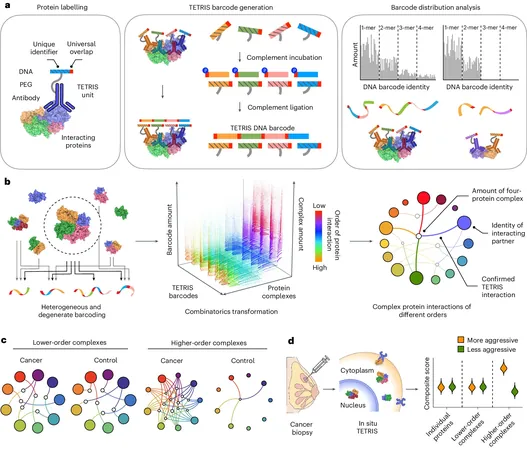
Revolutionary DNA Nanotechnology Breakdown: How TETRIS is Transforming Cancer Diagnostics!
2024-09-30
Unlocking the Mysteries of Proteins in Cancer Cells
TETRIS has the remarkable ability to identify and quantify multiple interacting partners in vast protein assemblies. This transformative technology captures the intricate hierarchy of protein interactions in tumor cells, shining light on the molecular mechanisms that drive the progression of cancer. Unlike traditional methods, which often fall short, TETRIS can deliver precise cancer diagnostics, allowing for the rapid sub-typing of cancers and the detection of aggressive forms of the disease within just a few hours—something previously deemed impossible.
This swift identification not only aids in accurate diagnostics but is also a game-changer for therapeutic strategies tailored to individual patients' needs. By pinpointing specific proteins and their interactions that contribute to tumor growth, doctors can employ targeted therapies that significantly improve patient outcomes.
The team’s findings were published in *Nature Biomedical Engineering* on June 19, 2024, underlining the significance and potential impact of their research.
Why TETRIS Stands Out in Cancer Research
Proteins are the essential building blocks of life, involved in nearly every biological process. Understanding how these molecules interact within our bodies is crucial not only for basic biology but also for developing effective treatments for diseases like cancer. Current methods for studying protein interactions have numerous limitations, such as yielding false results and incomplete profiling.
For instance, yeast-two hybrid assays, often considered the gold standard, require genetic manipulation and are only suitable for pairwise interactions, making them ineffective for clinical samples. Similarly, mass spectrometry-based proteomics struggles to capture weaker interactions due to extensive sample processing.
These traditional approaches fail to provide a comprehensive view of complex higher-order protein interactions—an important aspect as these interactions have been linked to more aggressive cancer types.
Harnessing DNA Nanotechnology
The researchers turned to DNA nanotechnology for a solution. "DNA is a programmable material, allowing us to encode intricate information and create complex architectures with nanometer-scale control," explained Assoc Prof Shao. By utilizing hybrid molecular structures as smart encoders, TETRIS maps protein interactions in real-time in patient samples. Each encoder carries a target-recognizing antibody paired with a DNA barcode, capturing both molecular identity and spatial relationships of proteins involved.
TETRIS measures both pairwise and higher-order interactions, offering a holistic view of the protein interactome. Imagine it as having delegates at a conference who 'shake hands' and exchange unique name tags—TETRIS effectively provides researchers with a visual account of how proteins interact at a cellular level.
Real-World Applications and Future Prospects
What sets TETRIS apart is its capability to perform on-site encoding and decoding in clinical samples. The technology has already shown success in analyzing breast cancer biopsies, accurately diagnosing cancer subtypes, and identifying higher-order protein interactions associated with aggressive cancer forms.
With the potential to integrate smoothly into clinical workflows and requiring minimal technical adjustments, TETRIS can process numerous samples rapidly. It could even allow rapid analysis from minimally invasive biopsy methods like fine-needle aspiration conducted in a doctor's office.
Looking forward, the researchers plan to extend the application of TETRIS beyond cancers, targeting neurological diseases and potentially laying the groundwork for new diagnostic and therapeutic innovations across a variety of medical challenges. They've filed two patents for this revolutionary technology and aim to bring TETRIS to market.
The Future of Cancer Care is Here!
As we edge closer to personalized medicine, TETRIS could become an essential tool in the fight against cancer, influencing clinical decisions and shaping the future of healthcare. Don't miss the chance to follow this groundbreaking innovation that promises to redefine not just cancer diagnostics but also how we approach treatment strategies for complex diseases. Stay tuned as we continue to uncover more details about TETRIS and its potential to revolutionize the world of medicine!









 Brasil (PT)
Brasil (PT)
 Canada (EN)
Canada (EN)
 Chile (ES)
Chile (ES)
 España (ES)
España (ES)
 France (FR)
France (FR)
 Hong Kong (EN)
Hong Kong (EN)
 Italia (IT)
Italia (IT)
 日本 (JA)
日本 (JA)
 Magyarország (HU)
Magyarország (HU)
 Norge (NO)
Norge (NO)
 Polska (PL)
Polska (PL)
 Schweiz (DE)
Schweiz (DE)
 Singapore (EN)
Singapore (EN)
 Sverige (SV)
Sverige (SV)
 Suomi (FI)
Suomi (FI)
 Türkiye (TR)
Türkiye (TR)